Catlinite
T-Pipes | |
| These pipes are made of solid sacred catlinite by fifth generation Oglala Lakota pipe maker Alan Monroe (read about Alan). The catlinite was mined from Alan Monroe's mine at Pipestone National Monument in Pipestone Minnesota. The stone has been buffed and polished to a high gloss with beeswax. Each pipe is signed by the artist and a Certificate of Authenticity is available upon request. Each pipe bowl is hand made and shaped to use the piece of catlinite to its best advantage. Some catlinite has dark and light areas: speckles are like light freckles; power spots are fewer and larger than speckles; two tone have large smooth light and dark areas. These variations are considered special and even sacred by many. |
Speckled
example. |
Solid
example. |
The
pipes below are one only, and the pipe shown is the one you will receive. | |
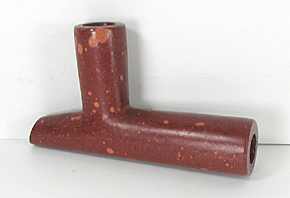 | 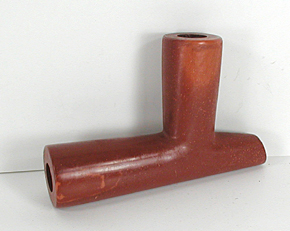 |
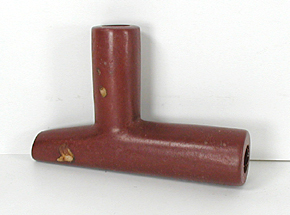 | 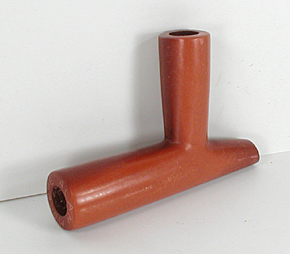 |
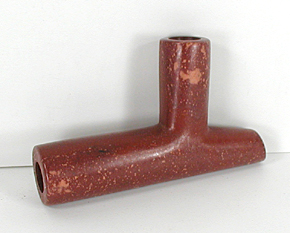 | 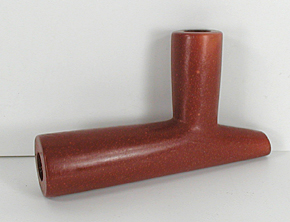 |
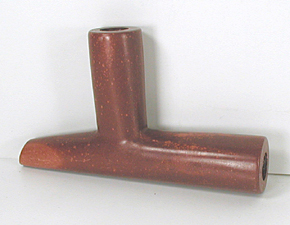 | 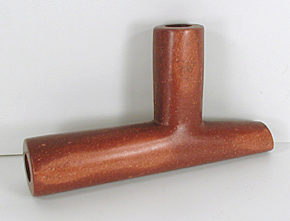 |
The hole for the stem insert is approximately 1/2" diameter¯ at the opening and tapers smaller as it goes toward the stack. Each pipe is signed by the artist. Stems are sold separately here. Important: - read how to properly insert the stem into the bowl. | |
About PipestonePipestone, also known as catlinite, is a form of clay called argillite with a high iron content that colors it a deep red to pale orange. Pipestone was discovered in southwestern Minnesota by the Sioux Indians, who consider it a sacred material and use it to carve pipes and other ceremonial objects. It is easy to carve because of its lack of quartz. The catlinite quarries located at Pipestone National Monument are considered sacred to many Native American people. Read more about Sacred Red Pipestone from Minnesota. |
"WHEN
YOU PRAY WITH THIS PIPE, YOU PRAY FOR AND WITH EVERYTHING.” Paula says - The quarries at Pipestone National Monument are sacred to many people because the pipestone quarried here is carved into pipes used for prayer. Many believe that the pipe’s smoke carries one’s prayer to the Great Spirit. The traditions of quarrying and pipemaking continue today. | |
The Sacred Pipe© 2010 Horsekeeping LLC © Copyright Information On first contact with Native Americans, the French used the word "calumet" [from the Latin "calamus", for reed] to refer to the sacred pipe. Early pipes of the Miami and Illinois were hollow canes decorated with feathers. The Lakota sacred pipe, the chanunpa, is an important part of healing ceremonies conducted by medicine men. Once a pipe is made, it must be blessed in a special ceremony that connects it to the original sacred pipe that was brought to the Lakota by the White Buffalo Calf Woman. This is to ensure that a good spirit resides in the pipe. The Sacred Calf Pipe bundle is the most sacred object of the Sioux. It was brought to them by a messenger (White Buffalo Calf Woman) from wakan tanka (the holy being, the great mystery, the source of all healing). The sacred pipe of the Osage is the Niniba. Pipes currently in use by the Plains Indians are made of a catlinite bowl and a separate wooden stem, usually made of alder or ash. The bowl can be a simple L shape or a T shape or can be a carving of an effigy or other symbol. The primary source of Catlinite is in Minnesota along Pipestone Creek which is a tributary of the Big Sioux River. This area under control of the US National Park Service is now named Pipestone National Monument. Native Americans can apply for a permit to quarry catlinite there. Catlinite is named for the New York artist George Catlin (1796-1872), who was the first white person to visit the Minnesota quarry from which it was obtained. Catlinite, a very deep red stone, is symbolic of blood of the ancient people and the buffalo. Although the words catlinite and pipestone are often used interchangeably, there can be a great difference in the two stones. Catlinite, with its dark red color and exceptional ability to be carved, is only found in the Minnesota mine. Pipestone found elsewhere in the US and the world has a different composition, is often a pale terra cotta color, and cannot be carved like catlinite. | |
Alan Monroe - Oglala LakotaAlan Monroe creates his Northern Plains artwork from hides, stone, leather, and wood. He learned the basics of quill working, weaponry, sculpting and pipe making from traditional and contemporary artisans in his family circle. He is a fifth generation pipe maker and considered by many to be a master pipe maker. In his sculptures, Monroe works with a variety of materials such as pipestone, bone, wood and alabaster. He creates small objects like fetishes to large pieces than can weigh hundreds of pounds. Al Monroe's work can be seen in many galleries and museums across the country and he has won many awards. Al Monroe was born in Hot Springs , South Dakota and is an enrolled member of the Oglala Sioux Tribe. He graduated from Hot Springs High School and studied business and art in Nebraska, Tennessee, and South Dakota. About Lakota Sioux | |
Using a Catlinite Pipe© 2010 Horsekeeping LLC © Copyright Information The bowl and stem are separated and carried along with a tamper, the smoking mixture and other smoking accessories in a bag or pouch. Each person has their own ritual about handing and smoking their pipe. It usually starts by smudging (purifying) the pipe and all of its parts and accessories in the smoke of sage, sweet grass, pine or cedar. Once the pipe has been purified, the stem is connected to the bowl, the stem being viewed as male and the bowl as female. A certain number of pinches of the smoking mixture are added to the bowl in ceremony. Each pinch is smudged before loading in the bowl. (Read about smudging.) The smoking of the pipe generally consists of puffing on it, not inhaling it. It is viewed as a means of sending one's prayers to the Great Spirit and making a connection between the earthly world and the spiritual world. As the pipe is passed, one holds the pipe in the left hand while using the right hand to wave the smoke over the top of one's own head as a blessing. When speaking to the Great Spirit, often the stem of the pipe is pointed toward the sky. In the hands of a medicine man, his sacred pipe is full of mysterious power and able to accomplish many things for the health, safety and well-being of his people. When smoking is finished, the pipe is again treated with great respect as the bowl is cleaned, the stem is detached from the bowl, the pipe is blessed and stored in its special bundle or pouch. | |
Storing a Catlinite Pipe© 2010 Horsekeeping LLC © Copyright Information According to Native American tradition, once a pipe has been smoked and blessed the first time, the bowl and stem of the pipe should only be joined for smoking. When they are joined, during smoking, the spirit of the pipe is released. After the ceremony, the bowl should be separated from the stem and they should be stored that way. If you store or display a pipe with the stem and bowl connected, the spirit is free to roam. | |
The Catlinite Offering Pipe© 2010 Horsekeeping LLC © Copyright Information The Offering Pipe is a small scale, less expensive version of the Sacred Pipe and is meant to be used as an offering or give-away. In many cultures, offerings are left at sacred sites and as a gift to the Spirits. In Native American culture, offerings might be left each time someone passes a certain way or takes water from a spring or stones from a mine. An offering can also be left for a person (alive or dead) or for a Spirit as a symbol of thanks and respect. The offering might be tobacco, food, money, flowers, craftwork or special objects. When a person goes on a Vision Quest the pipe that he smoked during that time would be one of the greatest offerings he could make to the Spirits. The Offering Pipe by Alan Monroe is perfect for such uses. When left as an offering, the pipe is separated from the stem and traditionally wrapped in red cloth which represents the red road or the good path. The bundle can be tucked in a rock crevice or a tree at the appropriate location. A Give-Away Pipe also has tradition in Native American culture. When someone dies, there is a ceremony similar to a wake where people come to pay respects to the departed. Sometimes an Offering Pipe is placed in the casket for burial with the deceased. (See above.) Also, the family passes out gifts to family and friends at this time as a symbol of the tradition of giving away some of the deceased's belongings. This is where a Give-Away pipe might be used. A year after the person has passed, a feast is held in the person's honor and the rest of the person's belongings are given away. This is another instance where a Give-Away pipe would be suitable to exchange between family and friends of the deceased. | |
Choosing a Catlinite Pipe© 2010 Horsekeeping LLC © Copyright Information If you are looking for an Offering Pipe or Give-Away Pipe, see above. For a personal pipe, generally the L-shaped bowls are thought to be for a woman, a single man or for an everyday smoking pipe. The T-shaped bowls are for a man or a family pipe. The nose of the pipe represents a man coming of age. The animal effigy pipes are for those who have aligned with a particular animal spirit. The pipes we sell at Horsekeeping.com are new pipes. They have not been smoked or blessed. Thank you to Alan Monroe, fourth generation Oglala Lakota pipe maker from South Dakota, for his amazing high quality pipes and works of art and for some of the information used in this article. | |
See More Home and Ceremonial Items |